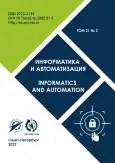Comprehensive Defense System against Vulnerabilities Based on Return-Oriented Programming
- Autores: Lubkin I.A1, Zolotarev V.V1
-
Afiliações:
- Reshetnev Siberian State University of Science and Technology
- Edição: Volume 21, Nº 2 (2022)
- Páginas: 275-310
- Seção: Information security
- URL: https://journal-vniispk.ru/2713-3192/article/view/266342
- DOI: https://doi.org/10.15622/ia.21.2.3
- ID: 266342
Citar
Texto integral
Resumo
Palavras-chave
Sobre autores
I. Lubkin
Reshetnev Siberian State University of Science and Technology
Email: lubkin@rambler.ru
newspaper Krasnoyarskiy rabochiy Ave. 48Б
V. Zolotarev
Reshetnev Siberian State University of Science and Technology
Email: zolotarev@sibsau.ru
newspaper Krasnoyarskiy rabochiy Ave. 48Б
Bibliografia
- Гласс, Р. Факты и заблуждения профессионального программирования // СПб.: Символ-Плюс. 2007. 240 с.
- Вишняков А.В. Классификация ROP-гаджетов // Труды ИСП РАН. 2016. Т. 28. Вып. 6, с. 27–36. doi: 10.15514/ISPRAS-2016-28(6)-2
- Vedvyas Shanbhogue, Deepak Gupta, and Ravi Sahita. Security Analysis of Processor Instruction Set Architecture for Enforcing Control-Flow Integrity // Proceedings of the 8th International Workshop on Hardware and Architectural Support for Security and Privacy (HASP '19). Association for Computing Machinery, New York, NY, USA. 2019. Article 8, 1–11. DOI: https://doi.org/10.1145/3337167.3337175
- Intel 64 and IA-32 Architectures Software Developer’s Manual Combined Volumes: 1, 2A, 2B, 2C, 2D, 3A, 3B, 3C, 3D, and 4 // https://software.intel.com/content/dam/develop/external/us/en/documents-tps/325462-sdm-vol-1-2abcd-3abcd.pdf
- Intel Launches World’s Best Processor for Thin-and-Light Laptops: 11th Gen Intel Core // https://www.intel.com/content/www/us/en/newsroom/news/11th-gen-tiger-lake-evo.html
- RAP: RIP ROP 2015 // https://pax.grsecurity.net/docs/PaXTeam-H2HC15-RAP-RIP-ROP.pdf
- Koo, Z.Z., Ayop, Zakiah, Abidin, Z.Z. Analysis of ROP attack on grsecurity / PaX linux kernel security variables // International Journal of Applied Engineering Research. 2017. no. 12. pp. 13179–13185.
- Иванников В., Курмангалеев Ш., Белеванцев А., Нурмухаметов А., Савченко В., Матевосян Р., Аветисян А. Реализация запутывающих преобразований в компиляторной инфраструктуре LLVM // Труды ИСП РАН. 2014. Т. 26. Вып. 1. С. 327–342.
- Нурмухаметов А.Р., Курмангалеев Ш.Ф., Каушан В.В., Гайсарян С.С. Применение компиляторных преобразований для противодействия эксплуатации уязвимостей программного обеспечения // Труды ИСП РАН. 2014. Т. 26. Вып. 3. С. 113–126. doi: 10.15514/ISPRAS-2014-26(3)-6.
- ИСП Обфускатор. Технология запутывания кода для защиты от эксплуатации уязвимостей // https://www.ispras.ru /technologies/isp_obfuscator/
- Нурмухаметов А.Р., Жаботинский Е.А., Курмангалеев Ш.Ф., Гайсарян С.С., Вишняков А.В. Мелкогранулярная рандомизация адресного пространства программы при запуске // Труды ИСП РАН. 2017. Т. 29. Вып. 6. С. 163–182. doi: 10.15514/ISPRAS-2017-29(6)-9.
- S. Crane, A. Homescu, P. Larsen. Code randomization: Haven’t we solved this problem yet? Cybersecurity Development (SecDev), IEEE. 2016.
- M. Conti, S. Crane, T. Frassetto et al. Selfrando: Securing the tor browser against de-anonymization exploits // PoPETs. 2016. no. 4. pp. 454–469.
- D. Williams-King, G. Gobieski, K. Williams-King et al. Shuffler: Fast and deployable continuous code re-randomization // Proceedings of the 12th USENIX Conference on Operating Systems Design and Implementation. 2016. pp. 367–382.
- Kangjie Lu, Stefan Nürnberger, Michael Backes, Wenke Lee. How to Make ASLR Win the Clone Wars: Runtime Re-Randomization // Proceedings of the 23rd Annual Network and Distributed System Security Symposium. 2016.
- Onarlioglu K., Bilge L., Lanzi A., Balzarotti D., Kidra E. G-Free: Defeating return-oriented programming through gadget-less binaries // Proceedings of ACSAC: M. Franz and J. McDermott, Eds. ACM Press. 2010. pp. 49–58.
- Jinku Li, Zhi Wang, Xuxian Jiang, Mike Grace, Sina Bahram. Defeating return-oriented rootkits with «return-less» kernels. // Proceedings of EuroSys. 2010, edited by G. Muller. ACM Press. pp. 195–208.
- Dean Sullivan, Orlando Arias, David Gens, Lucas Davi, Ahmad-Reza Sadeghi, Yier Jin. 2017. Execution Integrity with In-Place Encryption. arXiv preprint ar-Xiv:1703.02698 (2017).
- Lubkin I.A., Subbotin N.A. Technique of verified program module modification with algorithm preservation // IEEE Xplore Digital Library. 2017. 11th International IEEE scientific and technical conference "Dynamics of systems, mechanisms and machines" (Dynamics), 2017. pp. 1–5.
- Lubkin I.A., Bazhenov I. O. Methodology of software code decomposition analysis // Dynamics of systems, mechanisms and machines. Omsk. 2018. pp. 1–5.
- Hovav Shacham. The Geometry of Innocent Flash on the Bone: Return-into-libc without Function Calls (on the x86). 2007. ACM Conference on Computer and Communications Security (CCS), Proceedings of CCS, 2007. pp. 552–561.
- Статья Permutation conditions. URL: https://z0mbie.dreamhosters.com/pcond.txt (дата обращения 01.09.2021).
- Репозиторий с исходным кодом библиотеки eXtended Disassembler Engine (version 1.02). URL: https://github.com/nimrood/xde (дата обращения 01.09.2021).
- AMD64 Architecture Processor Supplement Draft Version 0.99.7 // https://www.uclibc.org/docs/psABI-x86_64.pdf
- Инструмент ROPgadget. Репозиторий с исходным кодом. URL: https://github.com/JonathanSalwan/ROPgadget (дата обращения 01.09.2021).
- Coremark. Программа оценки производительности. URL: https://github.com/eembc/coremark (дата обращения 01.09.2021).
Arquivos suplementares









